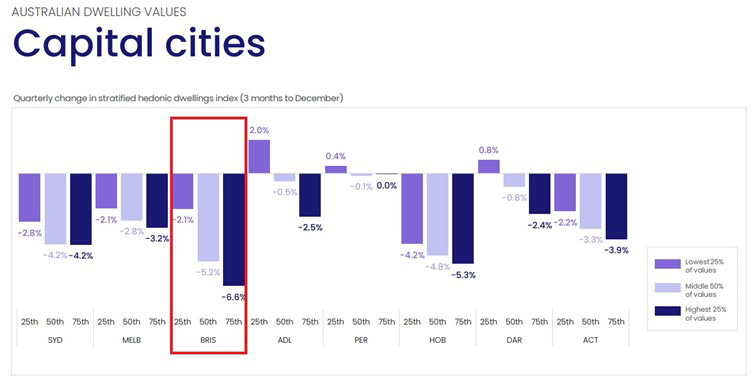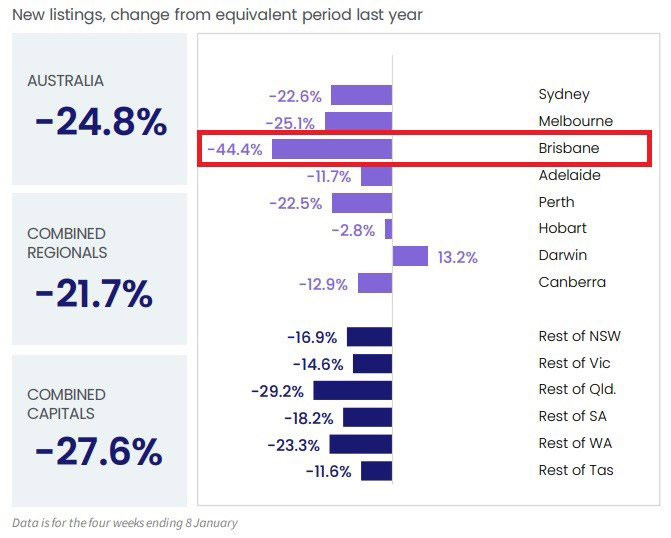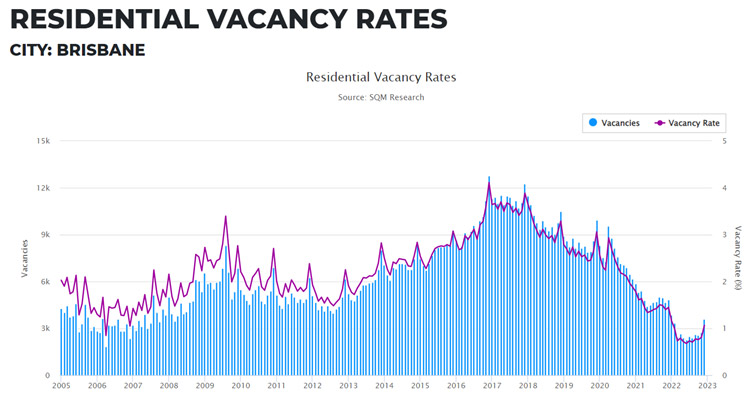Brisbane home opens, auctions busy but will this translate into higher prices?
Auctions and home opens are again drawing big crowds in Brisbane but will the Queensland capital overcome rising interest rates and low listing levels to end the price declines?
A higher volume of real estate buyers and the outperformance of units and townhouses over detached houses has marked the start of 2023 in Brisbane and marked a significant change from the end of last year.
The return of a semblance of urgency for some properties has raised the question of whether this is just pent-up demand that will return to a simmer, or does it mark a more significant turning point in the market?
It’s early days and there is not yet heightened demand across the board.
Some segments of the market in Brisbane appear to be stronger than others. The data between property types also confirms attached dwellings are still performing much better than detached dwellings throughout the city.
Lending data from the Australian Bureau of Statistics (ABS) confirms there is elevated borrowing activity, but most of this is refinancing. The national value of new loan commitments for housing declined 30 per cent between throughout 2022.

Source: CoreLogic.
The number of first home buyers has slumped across the country too, to be 53 per cent lower than the peak in January 2021. The value of new lending to property investors was down 28.3 per cent year-on-year in December 2022. It is likely new lending will continue to be impacted while the full impact of increasing interest rates flows through to households.
The composition of buyers in Queensland, according to the ABS, seems to be unchanged from June 2022 through to November 2022 with almost a quarter of borrowers being first home buyers and a third of borrowers being property investors.
Clearance rates, sales volumes and slashed
Auction clearance rates in Brisbane, according to Domain, almost halved in the first two weeks of 2023 compared to the same period in 2022, however, clearance rates are not always a reflection of the strength of the market.
More often they reflect the seller’s motivation to meet the market, more than the willingness of buyers to bid. The average number of registered bidders is increasing week-on-week in Brisbane, according to Apollo Auctions data.
Sales volumes year-on-year, according to CoreLogic, were down 19.3 per cent in Brisbane. Over the last three months, sales volumes in Brisbane declined 36.5 per cent relative to the same period last year. This was evident on the ground when we reflect on the fact that most of us in the industry worked right through Christmas and New Year 13 months ago, whereas the industry had a well-deserved break this year. There were fewer listings and fewer buyers active at that time.
A turning point for Brisbane property?
While this data indicates the market is not as strong as 12 months ago, there are signs Brisbane may have moved past the worst of market conditions.
It appears the Brisbane downturn is decelerating. Values within different price segments have not changed much over the last quarter, with the top 25 per cent of property values still showing higher median value declines than the bottom 25 per cent.
Based on this data, it could be interpreted that the higher value properties have been falling at a faster rate than the lower value properties throughout Brisbane.
What separates Brisbane from other markets across the country is the dearth of new listings.
With 44 per cent fewer new listings than 12 months ago, there are very few options for buyers to choose from. This is almost double the fall in new listings compared to all other locations throughout Australia.

Source: CoreLogic.
Price falls in Brisbane have been described this month as being the fastest pace of price falls in more than a decade.
Even so, price adjustments must always be considered in conjunction with the preceding gains.
In Brisbane, from Covid to the peak the market there was 42.7 per cent growth. The decline from the peak is now 10.7 per cent, according to CoreLogic, which overall equates to those who owned properties prior to Covid having seen capital appreciation of 27 per cent.
Among all state capitals, home values are only higher by an average of 11.7 per cent since March 2020.
Brisbane median dwelling values declined 1.4 per cent throughout January 2023. This equates to a quarterly fall of 4.8 per cent, and an annual change of -4.7 per cent. The median value for a dwelling in all of Greater Brisbane is now $698,204.
Units proving more resilient than houses
In January, house values declined more than unit values in Brisbane. It was reported that the monthly change for the median value of a Brisbane house was -1.6 per cent. The median value for a house in Greater Brisbane is now $773,509.
The change in values in the unit market is Brisbane has been a lot less severe than the housing market. In January 2023, units declined only 0.2 per cent with annual value changes still 5 per cent higher. The median value for a unit in Greater Brisbane is now $489,769, according to CoreLogic.
PropTrack data also shows annual growth in the unit segment of the market in Brisbane, with 5.52 per cent growth reported. In January, this data demonstrates growth of 0.33 per cent for Brisbane units and a median value at $544,000.
We remain uncertain about why each data set reports different results month-to-month and assert our position that on-the-ground observations must also be relied upon to come to a determination about what is really happening at a local level.
Brisbane rental market tight
The rental market in Brisbane is still extremely tight, with vacancy rates still well below long term trends. The small increase in December 2022, up to 1.1 per cent from 0.8 per cent in November, is likely to be a seasonal trend. Many tenancy agreements expire in the peak season at this time.
With vacancy rates still tight, rents continue to increase. Combined with property values trending down, it is good news for investors given gross yields are improving month-to-month.
Gross rental yields for houses in Greater Brisbane are now 4.1 per cent and for units it is even higher at 5.3 per cent, according to CoreLogic.

Source: SQM Research.
Investors may have been feeling the pinch with the higher costs associated with rising interest rates, it appears rent rises could be offsetting some of those costs across the board.
Rents have increased 12.5 per cent in Brisbane for houses and 15.3 per cent for units over the last 12 months. This is a significant price shift for tenants, many of whom may be reaching affordability caps with this rate of increase for living cost.
In the absence of any improvement in the immediate supply of rental accommodation, there’s no signs of reprieve for hard-hit renters.
Reading the market a tricky proposition
Based on the data, it would be easy to assume that the Brisbane property market is pretty flat but on the ground there are contradictory signs.
Activity is usually subdued until after the Australia Day Public Holiday but this year was different.
From the first open homes held by agents across the city there was heightened demand, an increase in buyers attending open homes, attending auctions and in the average number of registered bidders per auction.
While this might indicate more buyers have become active, it remains unclear if this will translate into stronger prices.
Consumer confidence is still very low and sensational media headlines can really impact consumer behaviour, regardless of whether the reported information is factual or not.
Traffic does not always equate to higher prices.
A gradual increase in attendees at open homes from August through to the end of 2022 did not correlate with increased urgency or competition.
The weeks ahead will determine if there has been a genuine shift in buyer sentiment in the face of rapidly rising interest rates.

















